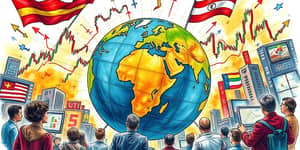
In the last decade, artificial intelligence has leaped from a niche research endeavor into a powerful force reshaping economies, societies, and daily life. No longer confined to one coastal corridor, AI is driving innovation from Toronto’s campuses to Bangalore’s tech parks and Dubai’s smart cities. This journey reveals a global AI landscape rich with diverse strengths, challenges, and aspirations.
According to recent surveys, an astonishing 78% of organizations worldwide now integrate AI in at least one business function, up from 55% a year earlier. Generative AI alone is regularly employed by 71% of these adopters, powering applications from content creation to predictive analytics. AI tools reach an estimated 378 million users globally as of 2025, an increase of 64 million since 2024, while half a billion people engage with AI daily.
The market’s value reflects this momentum: at approximately $391 billion in 2025, it is projected to grow at a compound annual growth rate between 31.5% and 35.9%, potentially surpassing $800 billion by 2030. Yet, monetization remains nascent; only about 3% of AI users currently pay for services, and ChatGPT converts just 5% of its weekly active participants into paid subscribers. As the industry matures, these figures signal vast room for growth and innovation.
On the workforce front, AI is both a disruptor and creator. Today, 90% of technology professionals leverage AI in their roles, and 1.8% of new jobs are AI-specific. Projections suggest AI could displace 92 million jobs by 2030 but also generate 170 million new positions, emphasizing the need for upskilling and adaptive policies.
While Silicon Valley remains the epicenter for foundational model development and venture capital, other regions are carving distinct niches. Academic pipelines, government strategies, and unique talent pools define these rising centers:
These hubs complement one another, fostering cross-border partnerships and competitive dynamism that enrich the broader ecosystem.
As AI permeates critical sectors, regulatory frameworks race to keep pace. Legislative mentions of AI have risen 21.3% across 75 countries since 2023—nine times higher than in 2016. Public trust skews toward the European Union, with 53% of citizens viewing it as the most reliable AI regulator, compared to 37% for the U.S. and 27% for China.
The fall in AI hardware and operational costs has been staggering: inference at GPT-3.5 levels is now 280 times cheaper than two years ago. Annual hardware cost reductions average 30%, while energy efficiency improves by 40% each year. Open-source models have dramatically closed performance gaps with proprietary systems, reducing benchmark differences from 8% to under 2% in just twelve months.
These advances underpin a global shift: emerging markets can now access sophisticated AI tools without Silicon Valley–scale budgets. In China, Indonesia, and Thailand, optimism about AI’s impact exceeds 75%, driven by applications in agriculture, finance, and education. Even in nations with cautious sentiment—such as the U.S. and Canada—public attitudes are warming as benefits become more tangible.
Despite rapid expansion, the AI revolution faces persistent hurdles. Talent competition fuels a global brain drain toward well-funded research centers. Compute access remains uneven, disadvantaging smaller economies. Meanwhile, the gap between free usage and monetized services suggests business models are still evolving.
By addressing these areas, policymakers and industry leaders can unlock AI’s full potential, ensuring benefits reach all corners of the globe.
AI’s influence extends beyond markets and regulations into everyday experiences. In healthcare, 66% of U.S. physicians now rely on AI-driven diagnostic tools, improving accuracy and patient outcomes. Breakthroughs in drug discovery—such as novel treatments for resistant infections—demonstrate tangible lifesaving potential.
At the same time, AI transforms creative industries: music, film, and design professionals collaborate with algorithms to explore new artistic frontiers. Educational platforms personalize learning at scale, while AI-powered translation tools bridge linguistic divides. Such developments reveal a world where technology fosters human connection and shared progress.
The next decade will define how AI reshapes global power dynamics, economic opportunity, and societal norms. By embracing collaboration, ethical stewardship, and inclusive innovation, stakeholders can build a future where AI’s benefits are distributed equitably, nurturing a truly global age of intelligence.
References













